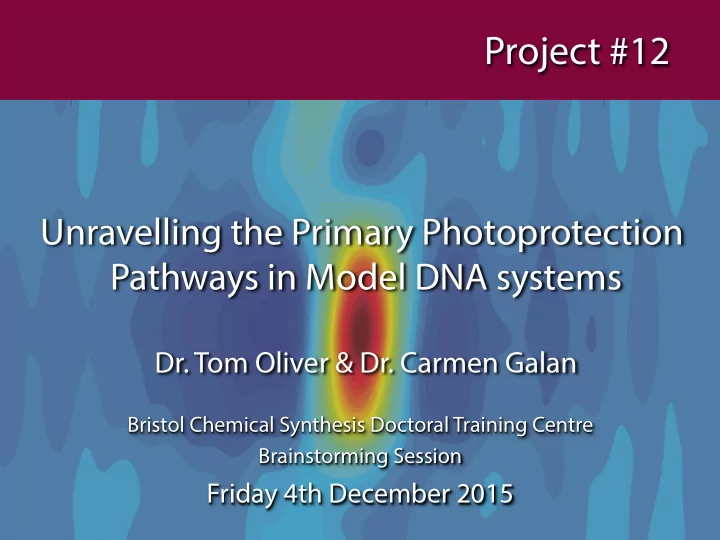

Project #12 Unravelling the Primary Photoprotection Pathways in Model DNA systems Dr. Tom Oliver & Dr. Carmen Galan Bristol Chemical Synthesis Doctoral Training Centre Brainstorming Session Friday 4th December 2015
DNA Nomenclature Primer • DNA is essential for cell growth, function and development • Comprised from speci fj c sequences of deoxyribonucleic acids nucleobase nucleoside nucleotide Double helix Polynucleotide DNA ribose (Primary structure) π -stacking H-bonding and DNA nucleobases π -stacking
Nucleobases vs Nucleotides • 90% of thymine molecules return to S 0 within 1 ps (1 ps = 1x10 -12 s) • When the sugar and phosphate groups are attached, branching into the 1 n π * state is enhanced signi fj cantly • For (dT) n , 10% of molecules decay on a nanosecond timescale (~1x10 -9 s) Deoxythymidine monophosphate
DNA Photoinduced Damage • Photoinduced lesions and reactions are correlated with the absorption spectrum of DNA bases • What are the links between DNA structure and damage?
1) What is the extent of delocalisation? • When DNA is photoexcited, how many nucleobases are excited? • What is the length scale of delocalisation, i.e. 2-8 bases? • How fast does energy transfer between adjacent moieties? A T G C • What causes the excited states to localise? – Solvent re-organisation? – Base, sugar or phosphate vibrations?
2) What is the Charge-Transport Mechanism? Incoherent sequential hopping Super-exchange through-bond tunneling • How far do h + and e - migrate? A C A C T A C A A T G T T G C A A T • Does it matter where charge- G T A T T G C A A C A T T G T A G T transfer is initiated? • DNA as a molecular wire?
Time Resolved Spectroscopies Probe wavelength / 10 4 cm -1 Signal = (Pump+Probe) – Probe Probe Negative features: excited states Positive features: ground states Pump-probe time delay / fs
Multidimensional Optical Spectroscopy • Optical analogue of 2D NMR: correlate optical absorption and emission
Absorption Spectra UV absorption spectra FTIR absorption spectra
2D Electronic-Vibrational Spectroscopy • Connect energy and structural landscapes with 2D electronic- vibrational spectroscopy • Use the vibrations as a “tag” for the physical location of energy • Monitor evolution of the system with increasing pump-probe time delay, T Original paper: TAA Oliver et al. , Proc. Natl. Acad. Sci. 111 , 10061 (2014).
Model systems Di-/oligo-/poly-nucleotides • Conformationally fm oppy, no π -stacking • Not representative of primary structure Hairpins or Dumbbells • Includes π -stacking and H-bonding • Can vary sequence/no. base pairs DNA primary structures: Di ffi cult to extract mechanistic details
Oligonucleotide Synthesis Using Phosphoramidites Oligonucleotide phophoramidite synthesis review: Wei, Tetrahedron , 69 , 3615 (2013)
Oligonucleotide Synthesis Using Phosphoramidites Oligonucleotide phophoramidite synthesis review: Wei, Tetrahedron , 69 , 3615 (2013)
Oligonucleotide Synthesis Using Phosphoramidites Oligonucleotide phophoramidite synthesis review: Wei, Tetrahedron , 69 , 3615 (2013)
Duplex Synthesis HN Target 1 O L ¡= ¡ ¡ ¡ ¡ O NH CN via ¡ HN OP DMTO NH N DMT, Dimethoxytrityl Duplex Synthesis: Letsinger and Wu, JACS , 117 , 7323 (1995). 15 ¡
Duplex Synthesis • What linkers will make good caps for the hairpin? Target 1 • How will you selectively couple the two oligonucleotides to the linker? I.e. avoid the following products:
Dumbbell Synthesis Target 2 • How will you alter the synthesis to cap the duplex making a rigid dumbbell?
Vibrational Tagged Dumbbells • Speci fj c IR tags are required on terminal/speci fj c nucleotides for “tag” experiments Target 3 • IR active functional group can be put on the sugar or DNA nucleobase • The vibrational needs to be distinguishable from current infrared active vibrations ring breath (RB) CO CO amino CO amino RB CO
Electron Injecting Linkers • What linkers could be used to inject electrons into Target 4 the duplex sequence? • This requires the linker to be a good electron donor, which upon irradiation (that does not excite DNA, > 310 nm) generating a radical anion • The anion radical oxidises the adjacent nucleobase, injecting electrons in the DNA sequence Electron Injecting linker: Lewis et al., JACS , 124 , 14020 (2002)
Speci fj cally Sequenced Dumbbells Target 5 • Through sequential phosphoramidite reactions, speci fj c sequences of polynucleotides will be synthesised • Think of strategies that ensure the correct sequence is assembled in the fj nal dumbbell
Gl Glyco-T co-Tools ools – ¡Galan ¡Research ¡Strategy ¡ Bio-‑Inspired ¡nanoprobes ¡for ¡ Novel ¡methodologies ¡for ¡ glycobiology ¡research ¡ oligosaccharide ¡synthesis ¡ and ¡modified ¡nucleo?des ¡ Glycan ¡ ¡ ¡ ¡ Angew. ¡Chem. ¡Int. ¡Ed. ¡2015, ¡54, ¡14719 ¡ Bioorg. ¡Med. ¡Chem. ¡LeR. ¡2015 ¡in ¡press ¡ Chem. ¡Commun. ¡2015, ¡51, ¡8939 ¡ Angew. ¡Chem. ¡Int. ¡Ed. ¡2014, ¡53, ¡810 ¡ Angew. ¡Chem. ¡Int. ¡Ed. ¡2014, ¡53, ¡8190 ¡ Org. ¡Biomol. ¡Chem. ¡2012, ¡10, ¡7091 ¡ Chem. ¡Commun. ¡2013, ¡49, ¡4217 ¡ Chem. ¡Commun. ¡(2010) ¡46 ¡(47), ¡8968 ¡ Angew. ¡Chem. ¡Int. ¡Ed. ¡2012, ¡51, ¡9152 ¡ ¡ Chem. ¡Commun. ¡2011, ¡47, ¡4526 ¡ ¡ Adv. ¡Synth. ¡Cat. ¡2011, ¡353, ¡2593 ¡ ¡
Funding ¡
Oliver Group Research Interests Design Principles of Natural and Arti fj cial Photosynthesis • Understand molecular mechanisms underlying energy transfer in natural light harvesting • Connect spatial morphology with Primary Photoprotection ultrafast properties of nanomaterial Pathways of DNA and photovoltaic materials • • J. Phys. Chem. B, 118 , 5382 (2014) Excited state delocalisation • • Nat. Phys. 9 , 744 (2013) Charge-transfer mechanisms • In fm uence of protein Development of New Optical environment on protection Spectroscopies mechanism • PNAS , 111 , 10061 (2014) • J. Chem. Phys., 142 , 174202 (2015) • J. Phys. Chem. B, 119, 11428 (2015)
Slides available from: http://taaoliver.com/bristol-chemical- synthesis-cdt/
Recommend
More recommend